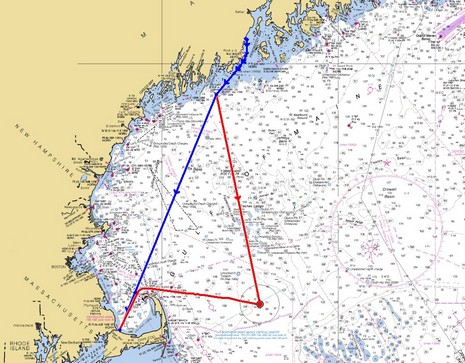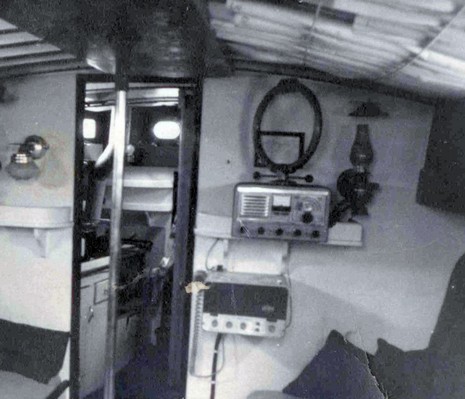RFU w/ RDF, so bad we missed Cape Cod

The mother hen of sailing blogs, Proper Course, is running an interesting project. Tillerman is inviting other bloggers to post entries about their worst sailing mistake, which he’s link to, creating a sort of master list of disasters. Well, yours truly firmly believes in the value of learning from the mistakes of others, and has made so many his own self that he’s hard put to pick a “worst.” Maybe this one; even though it took place a very long time ago, I remember one moment in the following true tale as though it were yesterday–shiver me timbers–and am fairly certain that I’ve been a better navigator ever since:
I believe it was sometime in October, 1972, when my boat partner Joe and I set off in our 40′ wooden sloop Alice (below), bound for a Chesapeake boatyard where he was going to work and winter aboard. We had two crew–Greg, a somewhat experienced sailor about our age, and Phil, an elderly but frisky lobsterman. Joe and I had owned the boat for a year and half (along with three other partners), taken her to Connecticut and back to Maine (several educational experiences included), and had spent part of the previous winter as crew delivering some of the first bareboats to the Virgin Islands (more education). Speaking for myself, I was by this point a classic case of “knowing enough to be dangerous”.
Come to think of it, I know we departed on a Friday because that first evening we tuned our teensy b&w Sony 12v TV into the nightly news and heard the weather man say something like, “If you’re planning to go boating this weekend, forget about it!” He was predicting an Easterly gale by the next (Saturday) afternoon. But we had already worked our way down Penobscot Bay and were south of Monhegan, happily broad reaching to a gray but steady northeasterly breeze. Considering where we were on the 107nm leg from the Monhegan Whistle to the buoy off Povincetown, we figured we’d be in the lee of the Cape before the weather got nasty. We figured.
So we fell into a fairly relaxed night of watches. We had a Walker taffrail log (I’ve still got it) and a good compass, and every hour or two would mark a new DR position along the rhumb line course I’d drawn on the paper chart. I’m not sure which large area chart we were using–West Quoddy Head to New York, I suspect–but I do know that it did not have magnetic compass roses. This happens on small scale charts when the magnetic Variation changes across the area covered. If you look at the bigger version of the chart above you can make out three dashed lines running SE to NW marking each degree change of Variation. We were in the 17 West variation zone, so that’s what I used in my calculations (you know, “True Virgins Make Dull Companions). We steered 185M to make a course of 202T.
I also had that fabulous Radio Direction Finder seen in the photo below (wish I’d saved it), and I used it a few times on two beacons, one to starboard near Portsmouth, NH, and the other to port on the Outer Cape. Mind you that RDFs had two nulls, i.e. they pointed two ways, toward a beacon and away from a beacon. It was assumed that you knew which was which.
The next morning the weather turned sour, but we were confident that we’d soon slide into the shelter of Cape Cod Bay. But we didn’t. By mid day it had gotten truly windy and rough, plus it was raining hard, and while our DR had us abeam P Town, the lumpy easterly seas sure didn’t make sense. And it got worse. And worse. Then there was the moment. With water every which a way I saw something to leeward that was solid, and the fundamental mistake suddenly dawned on me. I’d reversed the True to Magnetic calculation, subtracting 17 degrees instead of adding it. We weren’t on the line I’d drawn (blue); we’d been carefully DR’ing down a line that was actually 34 degrees (17 x 2) off! Plus, though it hardly makes sense looking at reconstructed voyage now, I must have been using the reciprocal of the Cape Beacon for the cross check.
So suddenly I knew that we were on the wrong side of Cape Cod, which meant to my soggy brain that what I was seeing in the spume to leeward might be a lifeguard stand on the beach in Truro. Bad! I called for a fast tack, which, in retrospect, might have been almost as dumb as my navigation mistake. We went off a wave and came crashing down so hard that the rigging went slack and the garboards starting leaking. Meanwhile, the object to leeward resolved itself as a large fishing vessel, which I recall was jumping around so weirdly that it looked like a fake boat in a movie.
But I was devastated. My little mathematical error could have been the end of us all, and our beloved boat was wounded. We spent another night out, cautiously working our way back around the Cape, the storm thankfully behind us and fading away. And we eventually got Alice to the Chesapeake, pumping all the way. (There we nailed sheet copper over the garboard seam, which did the trick, but she’d lost a little beam she never recovered.)
Lessons learned? Watch out for the really big–forest size–error that gets lost in the trees, sometimes abetted by an equally large secondary error. (Since steering 34 degrees “off course” for 18 hours was inconceivable, so was a reversed RDF null).
And remember the whole damned mnemonic: True Virgins Make Dull Companions, add Whiskey.














BenMan,
Once again, you have not only allowed us to smile at your writing and story-telling skill, damn good,
but you gently remind us to aware.
Thank you, neighbor. PL